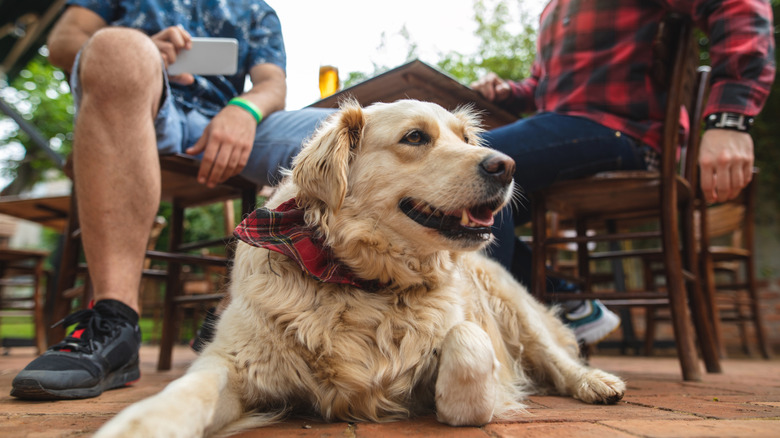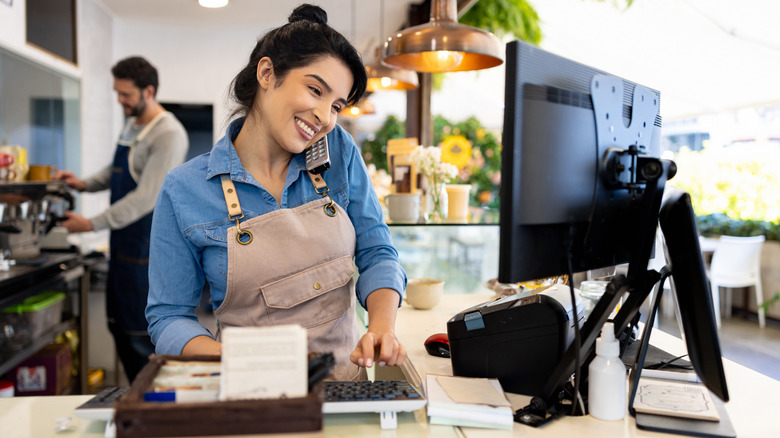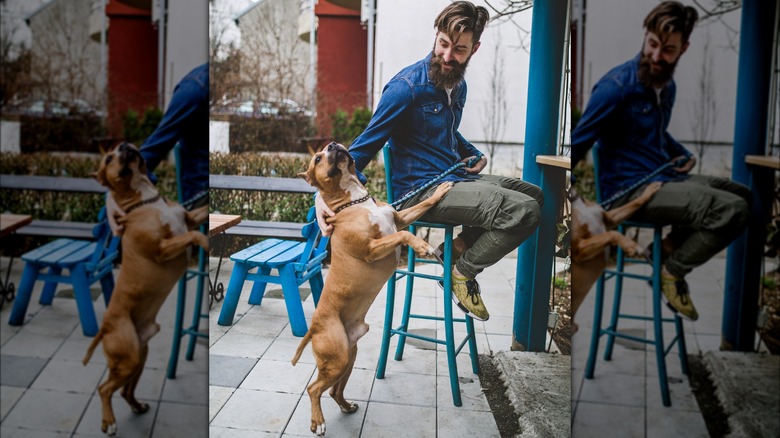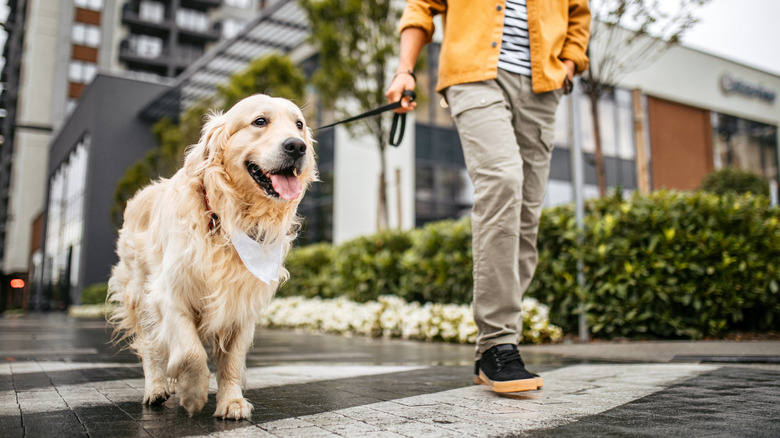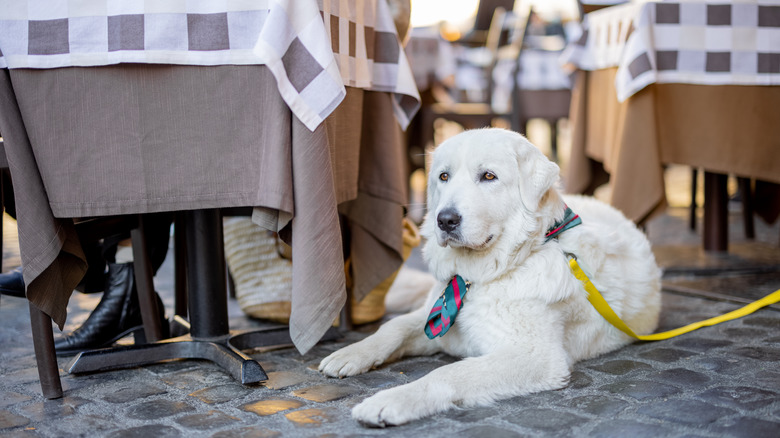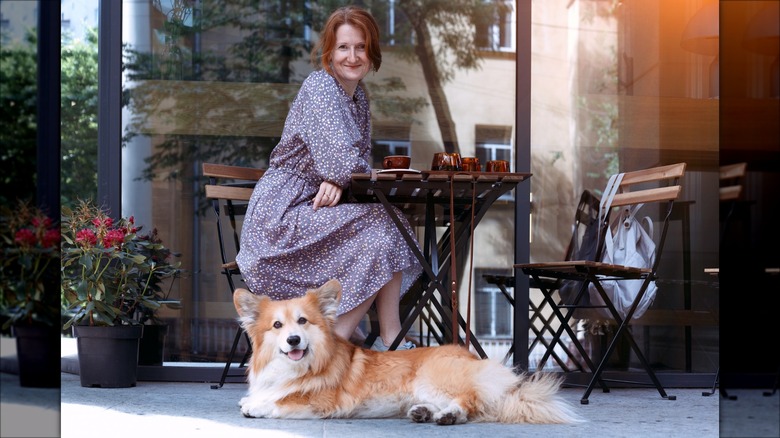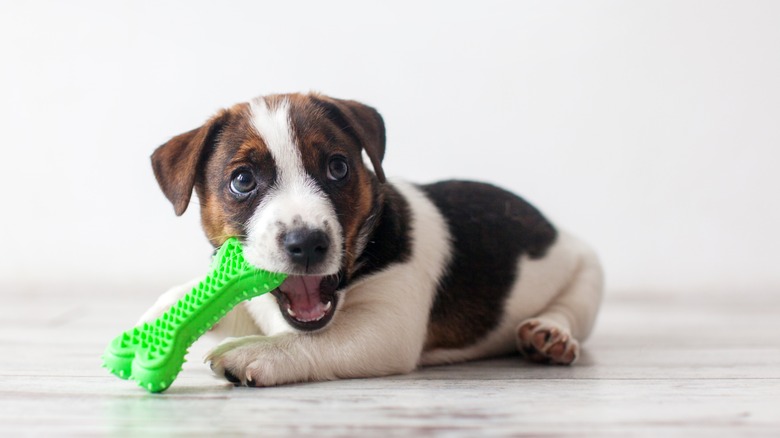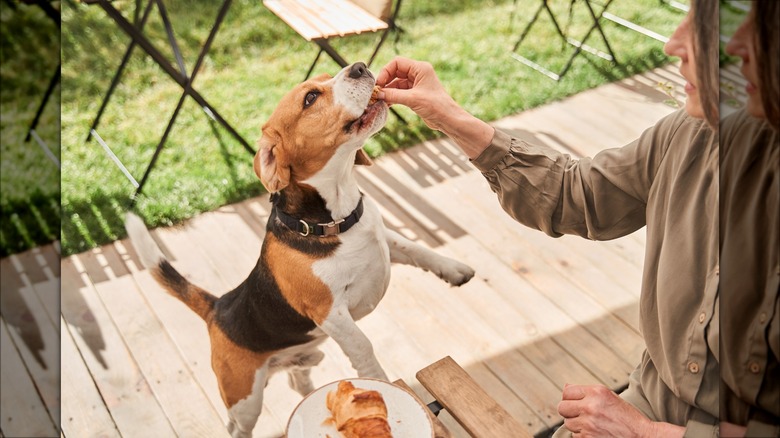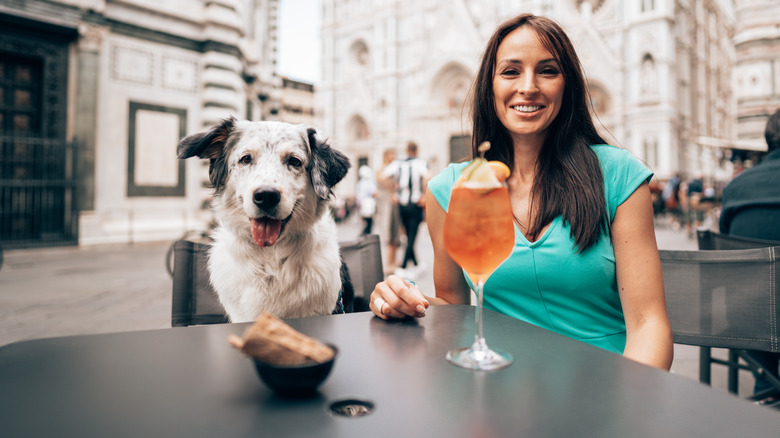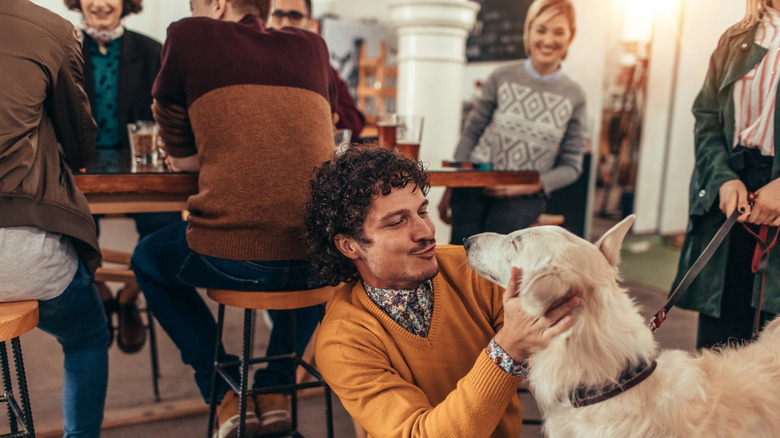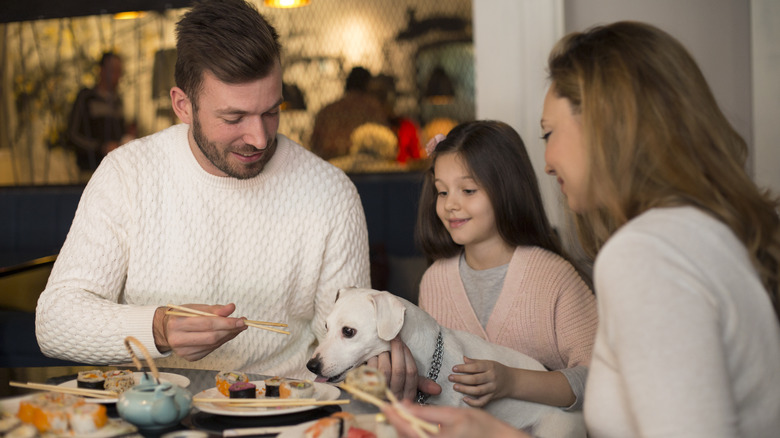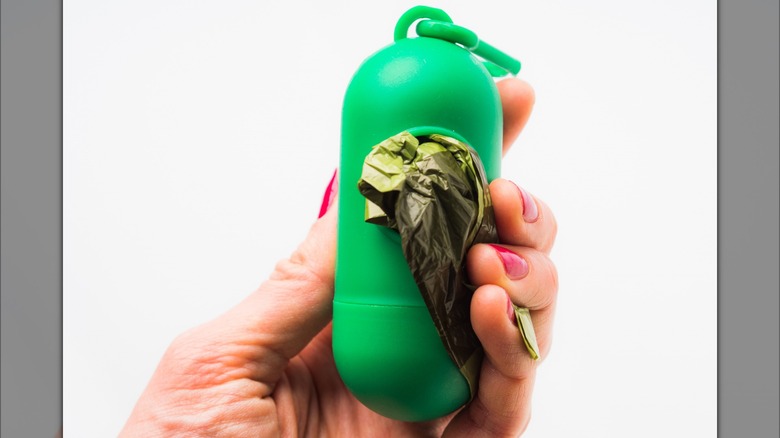11 Etiquette Rules To Keep In Mind When Bringing Pets To A Restaurant
Enjoying a meal out with your best friend is always enjoyable. This is possibly even more true when you're talking about your furry and forever faithful best friend. Sadly, many restaurants do not allow guests to bring their dogs. Finding one that allows you to dine with your dog can be a real treat — for both you and the pup.
However, before you rush home to get your dog and head to a nearby restaurant that allows pets, it is important to keep etiquette in mind. The restaurant might have more flexible rules that let you bring in a dog, but that doesn't mean that there are no rules whatsoever. Failing to be courteous and keep the restaurant owners, workers, and other patrons in mind will be a big mistake. You could end up making extra work for someone, scaring another guest, or worse. Read on to learn some of the most important etiquette rules that you should follow when dining out with your pup.
Contact the restaurant ahead of time to confirm policies and information
If you've recently heard about a new dog-friendly restaurant in your area, you will want to call to learn more about the rules and policies. Each restaurant's definition of dog-friendly could be different, so you'll want to gather all the information you can before bringing your dog out with you.
When you call, ask questions about whether pets are allowed at any time or only during specific hours. You will also want to find out where the outdoor seating is located (if it is near a busy street, for example, you might want to look for a different option). While speaking with a manager, ask how spaced the tables are to ensure that you won't be sitting right on top of another group of people who may or may not be comfortable with dogs. If you decide you want to visit, see if they accept reservations for the patio seats so you can make one before your visit. In addition to contacting the restaurant, you may be able to learn helpful information by reading through online reviews from other customers who have visited with their dogs.
Don't bring a dog that won't behave properly
While dog-friendly restaurants are great for many of our furry friends, they're not going to be a viable option for others. Some dogs just won't be able to handle the dining experience. Depending on the dog, they may bark or growl at other guests, try to steal food from you or others, jump up looking for attention from the server, try to play with other dogs that may be present, and more.
If you're not fully confident that your dog can be a respectful breakfast, lunch, or dinner date, then bringing them to a restaurant — even one that touts itself as being pet-friendly — just isn't a good idea. If you end up bringing a dog that won't be able to behave, you'll likely end up embarrassed, left paying extra money to cover damage caused by your pup, or upset with yourself for putting your dog in a situation that they couldn't handle. It just isn't worth it. If you have a new puppy, consider enrolling them in some training classes before trying to bring them to a restaurant.
Exercise your dog before going to the restaurant
Even if your dog is overall very well-behaved, being in a restaurant setting, potentially with other dogs, has the potential to make them more excited or nervous than normal. To help counter any behaviors that may arise from this, it is a good idea to make sure you give your dog a lot of exercise before bringing them to the restaurant. If they've already exhausted their energy and are a bit tired, they're more likely to remain calm and behave better when they're there.
Plan for plenty of time before leaving for the restaurant to take your dog for a long walk around the neighborhood. Bring them into the backyard to have them play around. If you have a longer drive to get to the restaurant, try to arrive at least 10 or 15 minutes early to leave time to take them for a walk around the block one last time before heading in.
Keep your dog on a leash
Keeping your dog on a leash when you're at a restaurant is just common courtesy. Even the most well-trained dogs can be tempted by a piece of food that drops at the table nearby. Similarly, if there are other dogs at the restaurant, your dog may react to them. Plus, while you love your dog and may love other animals, not all people feel this way. Some of the other restaurant patrons may feel more nervous seeing a dog off of a leash.
With a leash, you'll be able to keep your dog close to the table where you can feel confident that they're safe and aren't going to be able to get into any trouble. Choose a shorter leash, too — no more than 5 or 6 feet — to help you maintain control. If you have a retractable dog leash, be sure to lock it to a shorter length. Otherwise, your dog may end up halfway across the patio before you get a chance to react.
Choose the right spot to sit
Another important rule for dining out with your pup is to choose the right spot to sit (or to ask the restaurant staff to seat you in a particular section of the patio). Ideally, you should look to sit along one of the edges or in a corner where you won't be surrounded by too many people. If there are other dogs also sitting with their owners on the patio, choosing a table that is a bit away from them is also a good idea.
Being selective about where you sit is important for a few reasons. First, you want to make sure that your dog doesn't feel too overwhelmed. If other patrons and dogs surround them, they could feel threatened or nervous. Giving your dog some space should also help them refrain from jumping up at or barking at others simply because they won't be right next to them. The other reason to choose a spot that is distanced from other diners is to avoid making anyone else — human or canine — feel uncomfortable.
Bring something to keep your dog entertained
One way to keep your dog from barking, jumping up, or otherwise annoying other guests at the restaurants is to plan ahead. Just as you might bring a few toys to entertain a young child at the restaurant, doing so is also a good idea for your pup. You might want to bring a chew toy that they will stay busy nibbling on or another favorite toy that they enjoy hanging out with. Another idea is to use a toy designed to hold a few treats or dog food that will make your dog work to get at the yumminess hidden inside.
Ideally, they'll be so busy with these distractions that they won't get bored while you eat your meal. By staying entertained with whatever you bring, they should be able to cause any trouble, allowing you and the other diners at the restaurant to have a nice meal.
Don't give your dog food from your plate
Feeding your dog food from your plate when you're dining out at a restaurant is not a good idea for several reasons. First, by giving your dog even a small taste of something, they're going to think that there's a chance that they'll get more. This will encourage them to beg from you — and possibly from other guests at the restaurant — throughout the rest of the meal. Other guests at the restaurant aren't going to appreciate this and may also not think it is sanitary if they see your dog eating restaurant food.
Another key reason to avoid giving your dog food while you're dining out relates to their health. Restaurant food is likely to be more buttery or be cooked with seasonings that are not safe for your dog to eat. You're much better off feeding them before or after you eat out and bringing a few small treats with you; this way, you can feel confident that the food they eat isn't going to cause any adverse health effects.
Keep your dog on the floor, not on your lap or a chair
If you're like many people, bringing your dog to a restaurant is not something you do on a regular basis. For this reason, it can feel like a truly special occasion, and you may be tempted to try to make it even more "special" for your pet by letting them sit on your lap or the chair next to you. However, doing so isn't a good idea. If your pup is up by the table, they're going to be more tempted to beg for food or even try to steal it off of your plate. Other restaurant guests are also unlikely to appreciate seeing your dog sitting up at a table.
Where you have your dog sit on the floor is also important. You want to make sure that they're in a spot where they won't be in the way of the servers or other people walking around the table. You don't want someone to trip on the dog, resulting in an injured pet and an injured person.
Be purposeful about what time you go to the restaurant
Thinking about timing when bringing your dog to a restaurant is key. When possible, try to avoid going when the restaurant is likely to be busy. This could mean planning an earlier or later dinner than you normally would prefer. Going during a less busy time will provide you and your pup more space. They'll be more likely to remain calm throughout dinner than if there were tons of people or other dogs crowded around them. If you're not familiar with the restaurant, consider calling to find out what days/times they're likely to be a bit less busy.
In addition to being purposeful about when you dine out, also consider how long you're sitting at the table. If you're bringing your pup to dinner with a group of friends, there are better times to linger after you've finished your meal to have an extended conversation. Even the most patient dog is going to reach their limit, so try to eat rather quickly and move on with the rest of your day.
Be prepared for the unknown
One thing you'll need to accept when bringing your dog to a restaurant is that the experience may not go as planned. This is a risk we must all take when animals are involved. Even if your dog is well-trained and knows how to behave, you don't know what other dogs will be there, how they might act, and whether they're likely to trigger any sort of response from your dog.
Being prepared for something unexpected to happen and having a general plan for what you will do in different situations is a good idea. For example, if there is another dog that's really barking or growling at your dog, perhaps it will be a good idea to ask your server if you can be moved to a different table. If your dog seems more excited or active than you thought they would be when dining out, the best option may simply be to place your order to-go and bring it home to eat instead.
Clean up any messes left by your dog
As a pet owner, you're likely used to cleaning up the messes your dog makes, whether inside the house, in the backyard, or along the sidewalk when you're out for a walk together. When you're out with them at a restaurant, you should still view it as your responsibility — not that of your server — to clean up after them. Try to leave the space under your table as it was when you arrived at the restaurant to avoid making extra work for the staff.
This means that you should come prepared for the possible messes your dog could create. Bring some wet wipes, poop bags, some extra napkins or paper towels, and a spray bottle with water. With this clean-up toolkit, you should be able to take care of whatever "presents" your pup leaves behind. The restaurant staff will appreciate any steps you take to prevent adding anything else to their already busy schedule.
